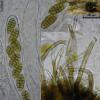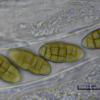
01-01-2026 18:35
Original loamy soil aside a artificial lake.The co

31-12-2025 19:27
Collected from loamy soil, at waterside (completel

30-12-2025 16:44
Pascal DucosBonjour,Une anamorphe rose stipitée, très nombre

30-12-2025 17:14
 Bernard CLESSE
Bernard CLESSE
Bonjour à toutes et tous,Pourriez-vous aider Albe

29-12-2025 10:15
Hulda Caroline HolteHello, I found and collected this propoloid ascom

30-12-2025 09:04
Hello.A Pyrenomycete sprouting sparsely but very d

29-12-2025 17:44
Isabelle CharissouBonjour,J'aimerais savoir si d'autres personnes au
Capronia-like but dothideal
Hans-Otto Baral,
23-04-2010 22:14
 Hi
HiHere is a sparse collection by Guy Marson, on a 7 mm thick dead, hanging branch of ?Cornus (on wood). Macroscopically like a Capronia, but cylindrical asci and presence of paraphysoids clearly show that it is not.
I did not see this material, the data are from Guy:
Spores muriform, bright ochre-brown (never blusih-grey-brown as typical of Capronia), 14,5-19,5 x 6,2-8,5 µm.
Asci *95-115 x 13-17 µm, inamyloid (IKI, with or without KOH).
Hairs up to ca. 130-140 x 4,5-5,5 µm, thick-walled, yellowish-brown, apically more thin-walled.
Zotto
Jacques Fournier,
24-04-2010 11:35

Re:Capronia-like but dothideal
Hi Zotto and Guy,
not a Capronia, I agree. Such small hairy things with brown muriform spores can be found in Pleospora as defined by Wehmeyer (1961). His concept of Pleospora was very large and I always failed to identify a collection to species with his key. He reported many species as setose or tomentose but did not emphasized this character as distinctive enough.
Recent molecular results indicate the name Pleospora should be restricted around P. herbarum to species occurring on herbaceous substrates, but the taxonomy of species on wood, mosses, lichens etc is still very poorly known.
Sorry I have no better idea.
Cheers,
Jacques
not a Capronia, I agree. Such small hairy things with brown muriform spores can be found in Pleospora as defined by Wehmeyer (1961). His concept of Pleospora was very large and I always failed to identify a collection to species with his key. He reported many species as setose or tomentose but did not emphasized this character as distinctive enough.
Recent molecular results indicate the name Pleospora should be restricted around P. herbarum to species occurring on herbaceous substrates, but the taxonomy of species on wood, mosses, lichens etc is still very poorly known.
Sorry I have no better idea.
Cheers,
Jacques
Alain GARDIENNET,
24-04-2010 15:07
Re:Capronia-like but dothideal
I'm agree with Jacques and since yesterday, I search in Pleospora (sensu largo) without success.
Questions for Guy :
Are the setae around ostiole or around ascomata in full ?
Are the spores ornemented ?
Have you find immersed ascomata ?
Have you a description of the peridium ?
Alain
Questions for Guy :
Are the setae around ostiole or around ascomata in full ?
Are the spores ornemented ?
Have you find immersed ascomata ?
Have you a description of the peridium ?
Alain
Hans-Otto Baral,
24-04-2010 21:33

Re:Capronia-like but dothideal
Thank you both! Good to have at least an idea of the relation. Guy made quite a long description (in German). He emphasized that the perithecia are a bit immersed (unlike Capronia).
The hairs emerge about in the middle of the pseudothecium and go up to the ostiolum. The latter is about at the level of the hair tips and therefore visible, contrary to Capronia.
The peridial cells he did not describe.
I think the spores are completely smooth, on the photos at least is nothing to see.
Zotto
The hairs emerge about in the middle of the pseudothecium and go up to the ostiolum. The latter is about at the level of the hair tips and therefore visible, contrary to Capronia.
The peridial cells he did not describe.
I think the spores are completely smooth, on the photos at least is nothing to see.
Zotto
Guy Marson,
25-04-2010 10:21
Re:Capronia-like but dothideal
Thanks to everybody, Zotto, Jacques and Alain,
Jacques:
- I agree, Pleospora (s.l.) is a good idea. Unfortunately I only got very sparse material of this collection. Yesterday I've been once more at the collection spot, but without success.
Zotto:
- another possible substrate is (!)Viburnum (?)lantana growing there too.
Alain:
- The setae start growing in about the middle part (the non immersed part) of the pseudopthecia.
- With the LM I could not see any ornamentation on the spores. The attachment cells of the setae are maybe a little rough. Both should be confirmed by SEM observation.
- Yes, they are somewhat immersed, let me say, the lower half is immersed.
- about the peridium: sorry, no observation done so far. I hope to find more material to give a better description.. (I'm sure, this was not my first encounter with this fungus, but pyrenos are not "my group" so, hmmm... ).
Cheers,
Guy
Jacques:
- I agree, Pleospora (s.l.) is a good idea. Unfortunately I only got very sparse material of this collection. Yesterday I've been once more at the collection spot, but without success.
Zotto:
- another possible substrate is (!)Viburnum (?)lantana growing there too.
Alain:
- The setae start growing in about the middle part (the non immersed part) of the pseudopthecia.
- With the LM I could not see any ornamentation on the spores. The attachment cells of the setae are maybe a little rough. Both should be confirmed by SEM observation.
- Yes, they are somewhat immersed, let me say, the lower half is immersed.
- about the peridium: sorry, no observation done so far. I hope to find more material to give a better description.. (I'm sure, this was not my first encounter with this fungus, but pyrenos are not "my group" so, hmmm... ).
Cheers,
Guy
Xavier LLIMONA,
26-04-2010 13:42
Re:Capronia-like but dothideal
Essayez:
http://bibdigital.rjb.csic.es/spa/Libro.php?Libro=2740&Pagina=4
dans l'ensemble de la thèse de Dolores SIERRA
http://bibdigital.rjb.csic.es/spa/Libro.php?Libro=2740&Pagina=4
dans l'ensemble de la thèse de Dolores SIERRA
Guy Marson,
27-04-2010 02:04
Re:Capronia-like but dothideal
Salut Xavier,
je vais essayer de me procurer d'une traduction de l'espagnol dans langue convenante.
Merci pour le tuyau!
Amitiés,
Guy
je vais essayer de me procurer d'une traduction de l'espagnol dans langue convenante.
Merci pour le tuyau!
Amitiés,
Guy




